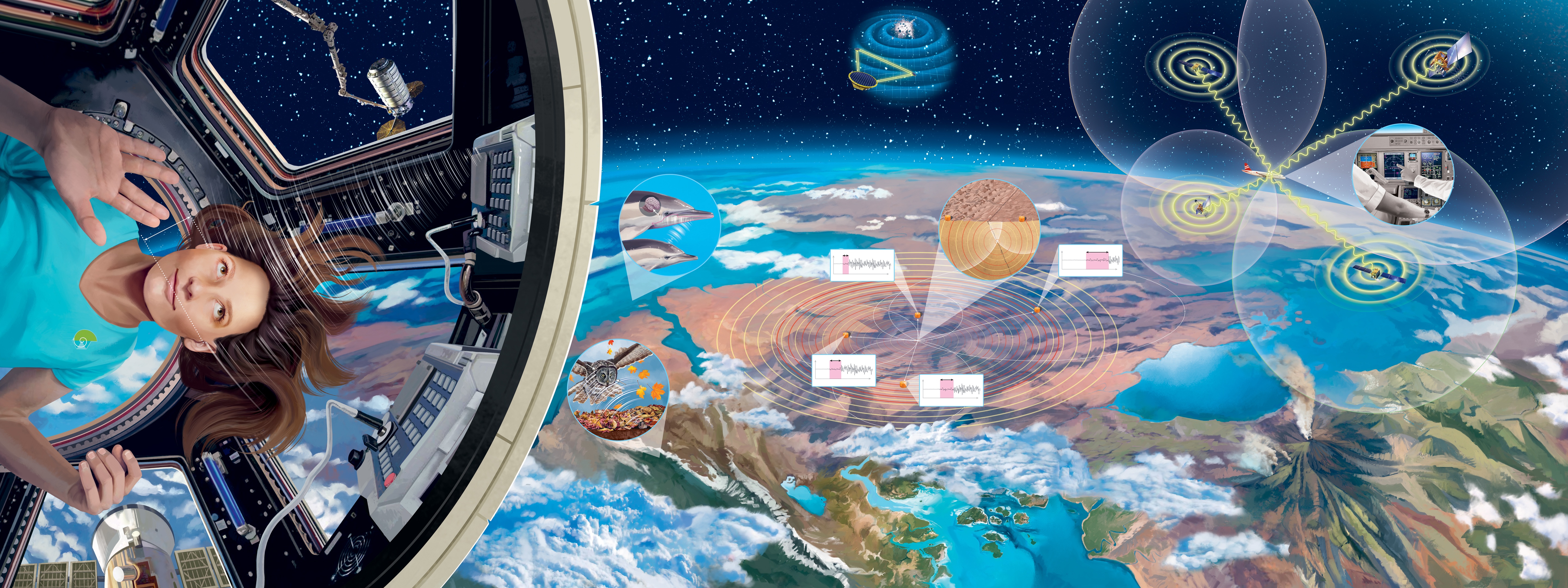Seek and You Will Find
Using waves for localisation thanks to their three-dimensional propagation
A wave propagates in all directions. If there are enough receivers within its range, the wave’s place of origin can
be determined from the received signals. To determine our own location, we use waves that reach us from different
places.

Earthquakes & Gravitational Waves
Earthquake waves can be used to determine where an earthquake originated (its hypocentre). This is done using instruments that ‘hear’ earthquake waves. The closer such a seismometer is to the hypocentre, the sooner the waves arrive. If we know their arrival times at different seismometers, we can roughly gauge in which direction the hypocentre lies.
For an exact localisation, we have to determine the distance from each seismometer to the hypocentre. To do this, we use the fact that different earthquake waves are generated at the same time but reach a seismometer at different times. Close to the hypocentre, the time difference between the arrival of the P wave and the slower S wave is small; as the distance increases, it becomes larger and larger. The difference in arrival times together with the wave velocities is then used to calculate the distance from the seismometer to the hypocentre. If we combine all these distances, we can determine where the hypocentre is located. The better we know where earthquakes occur, the more precisely we can estimate how earthquakeprone a region is.
The sources of gravitational waves in space can also be localised. The LISA mission plans to measure gravitational waves using three satellites in space. Here, there are fewer interfering signals than on Earth and the measuring instruments can be placed extremely far away from each other. This should enable not only more precise measurements, but also more precise localisation than on Earth.
Positioning
A location can be determined with navigation systems such as GPS (Global Positioning System). This is how we know where we are on a map and how aircraft can follow their flight path.
To determine our location, we receive signals from several satellites. These electromagnetic waves tell us the positions of the satellites from which they were transmitted and the exact time at which they were sent. Together with the time of reception, our GPS device determines how long each signal took to reach us. This time combined with the velocity of the waves – the speed of light – gives us the distances to the respective satellites. Combining this information from several satellites lets us determine our own location.
The location determination is inaccurate if the signals are not travelling at the assumed speed of light. This occurs if the waves are slowed down along the way, e.g. by buildings or weather phenomena. In these cases, the speed of light used by the GPS device is too high and thus the calculated distance to the satellite is farther than reality.
Sounds
We can not only hear sounds, but also assess where they come from. We are particularly good at distinguishing whether a sound is coming from the left or the right. This is due to our ears sitting on either side of our head, so that the ear closer to the source of the noise receives the sound wave slightly earlier than the other.
We can also estimate how far away a sound source is. To do this, our brain evaluates the volume and the wavelength of the received sound waves: the farther away the source, the quieter the sound and the fewer short wavelengths (high-pitched sounds), as these lose energy quickly.
Animals that use sound for navigation and hunting prey have a much higher localisation accuracy than humans. They are much better at distinguishing if a sound is coming from above or below and from ahead or behind. In bats, this is probably due to the shape of their auricles; in some owl species it is due to the asymmetric positioning of their ears.
Dolphins are also very good at locating sounds, but they hear in a completely different way: the sound is transmitted from the water directly into their lower jaw bone. This is called bone conduction, and its influence on the accuracy of localisation is particularly interesting for medicine, because bone conduction implants are being used to help humans with hearing impairments.